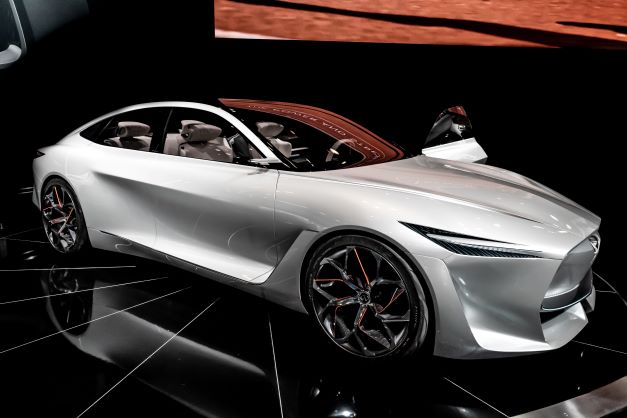What Will My Car Look Like In 5 Years' Time?
30 Dec, 20195:31Unless you’re a real petrolhead, it’s not likely to be a question you’ve a...

Unless you’re a real petrolhead, it’s not likely to be a question you’ve asked yourself.
That is, ‘what will my car look like in 5 years time’?
From the outside, little is likely to change- apart from the usual minor styling tweaks that most models of car undergo every few years (plus many aspects of exterior car design are now strictly governed by regulation to protect pedestrians and other motorists from undue harm in the event of an accident).
It’s on the inside of your car that you should expect to see some revolutionary changes.
Revolutionary is a strong word. But such are the changes on the horizon, that we’d say it’s justified.
From electric motors to infotainment systems and advanced driver assistance systems to remote vehicle management, over the next five years cars, and the people that build them, are going to change.
Take a look at the infographic below to find out more about these developments and what they’ll mean for you and your car.
As we said, there are some radical changes on the way.
The motor
Arguable the biggest change to cars of the future- because of the wider impact it will have upon the automotive industry, the manufacturing supply chain, raw material demand, the electricity grid, and national infrastructure- will be the transition to electric motors.
Electric motors, when compared to traditional internal combustion engines, are a simpler motor made up of fewer components. As a result, this could have a negative impact upon automotive manufacturing jobs in what we here at Fircroft have dubbed The Great Powertrain Transition.
Power source
If they aren’t already, the owners of fuel stations should start worrying.
If electric vehicles take off in popularity to the degree that has been predicted by manufacturers and public policy makers, then fuel stations face a bleak future.
Indeed, fuel retailers have already seen the writing on the wall and are looking ahead to a fossil fuel free future.
The transition away from fossil fuels has been given a major boost by the UK government’s announcement in July 2017, that all new diesel and petrol vehicles will be banned from sale from 2040.
Thus, the battery source for cars in the future will be batteries. The power source used in electric vehicles is often Lithium-ion batteries. Li-ion batteries are lightweight, and store more energy than traditional lead-acid batteries.
However, the humble battery- in its many forms- hasn’t noticeably advanced in decades. But this situation is changing. Now, large technology companies and car manufacturers are teaming up to invest in battery development.
Here are just a few examples of future battery technologies that are currently in development:
- Lithium-air breathing batteries: using oxygen as the oxidiser. This technology has the potential to make batteries cheaper, lighter and keep their charge up to five times longer.
- Gold nanowire batteries: experts at the University of California have experimented with Nanowires (a thousand times thinner than a human hair). Despite initial difficulties with recharging, the use of gold nanowires in a gel electrolyte has solved these problems and can be recharged over 200,000 times.
- Solid state lithium: Toyota has investigated the use of sulphide superionic conductors in the place of electrolyte transmissions. This could mean charging within 7 minutes and the ability to function at temperatures as low as -30°c.
In-car connectivity & infotainment
It’s no exaggeration to say that in the future, your car will be your media hub- keeping you connected and entertained throughout the day (even when you’re nowhere near it).
Not only that, but manufacturers are transforming connectivity by using vehicle data to enable customers to interact with things outside the vehicle. Consider the following:
- Your car will be integrated with your home security.
- Vehicles will act as Wi-Fi hotspots.
- Wearable devices will connect to your vehicle to monitor your vital signs whilst you are driving.
- Your in-car entertainment system will be able to stream music and video to your smartphone whilst you are out and about away from your car.
- Haptic feedback will improve driver safety, such as steering wheel vibrations during lane changes without prior indication.
These changes come at a time when people are spending more time than ever in their cars. For example, it is estimated that the average American spends 280 hours behind the wheel each year, increasing the demand for improved productivity and even entertainment during that time.
From mechanical to electronic functionality
As electric vehicles become more prevalent, their manufacturing process follows suit. Mechanical functionality will be superseded by electronic functionality.
But what exactly do we mean by this?
Let’s take a look at some examples:
- Electronic brake distribution: rather than relying on traditional, purely mechanical, braking systems, cars of the future will have electronically enhanced 'electronic brake distribution', which automatically varies the amount of braking force applied to each wheel, making the act of braking safer and more effective.
- Electronic driver assistance: a variety of traditional Electronic Control Units (ECU) are being combined to offer multiple functionalities in one system. In particular, Advanced Driver Assistance Systems (ADAS) which include:
- Driver alerts to avoid collisions / accidents.
- Automated safeguards to take over the vehicle if necessary.
- Adaptive cruise control.
- Automated braking systems.
Remote vehicle management
Imagine never having to take your car to the garage for a service again.
Well, remote vehicle management will make this scenario at least partially possible in the future (we’re sure that there’ll still be occasions when a trip to the garage is unavoidable).
So, what exactly is remote vehicle management?
In short, connected car applications sit at the heart of remote vehicle management and are expected to streamline vehicle maintenance and even reduce running costs. Rather than a regular service, software updates will be completed remotely in super-fast time. Maintenance and repairs could be scheduled based on vehicle performance data.
Not only that, but connected car applications will bring other benefits:
- Optimised navigation routes.
- Tracking of vehicle performance.
- Monitoring of fuel / energy consumption.
- Automated scheduling of maintenance and repairs.
- Remote 'over-the-air' updates.
- Monitoring of vehicle location.
The monitoring of your vehicle in real time will help to keep track of performance, but will also enable optimisation of navigation routes, and even help find you an empty parking space!
Connected cars will also improve the driver experience by monitoring fuel / energy consumption and suggesting the next service station with the cheapest fuel / recharge point within range.
Autonomous driving & vehicle-to-vehicle communication
In the future, it won’t just be automotive manufacturers that will have had a hand in developing your car, but telecoms companies too.
Vehicle-to-vehicle communication will bring a number of benefits:
- Information transmission between vehicles and other objects on the road.
- The creation of a complex ecosystem of road users that will ensure optimal driving strategies- reducing journey times and increasing safety.
- Preventing automobile accidents by alerting drivers before they occur.
- Monitor and adjust position on the motorway based on distance between other vehicles.
- Broadcast of position, speed, steering-wheel position and brake status.
Augmented Reality (AR) dashboards
Currently only available on a wide-spread basis on high-end smartphones, expect Augmented Reality (AR) to have made the transition to your car dashboard in five years time.
What will an AR dashboard do exactly?
- Identify objects in front of the vehicle using inbuilt cameras and highlight them to the driver.
- Identify other vehicle movement.
- Highlight pedestrians.
- Avoid driver distractions.
- In-car cameras will monitor the driver's position.
- Indicate the correct lane based on route and destination.
Ultimately, AR technology will increase driver safety on the road by reducing potential accidents and collisions.
Energy-storing body panels
With Lithium-ion batteries being both heavy and bulky, several automotive manufacturers are currently exploring alternative means of storing energy in-vehicle for electric vehicles.
Both Volvo and Toyota are currently researching the benefits of using lightweight energy-storing body panels.
It is expected that the panels will reduce the weight of a vehicle by up to 15%, capture energy from regenerative braking and also store energy from solar capture.
The car of the future needs the workforce of the future
So, what will your car look like in 5 years' time?
We hope that the information outlined above provides some indication of what you can expect to experience.
One thing certainly is clear though.
Not only are the cars of the future going to be very different- so too will be the workforces that are going to be building them. The transition towards new forms of power, electric motors, infotainment systems and much else means that the skills composition of the automotive workforce will be very different from at present.
Automotive manufacturers need to start planning now to ensure they can secure workers with the skills and experience they need to build the cars of the future.
Fircroft can help you build a workforce that is fit for the future- today.









